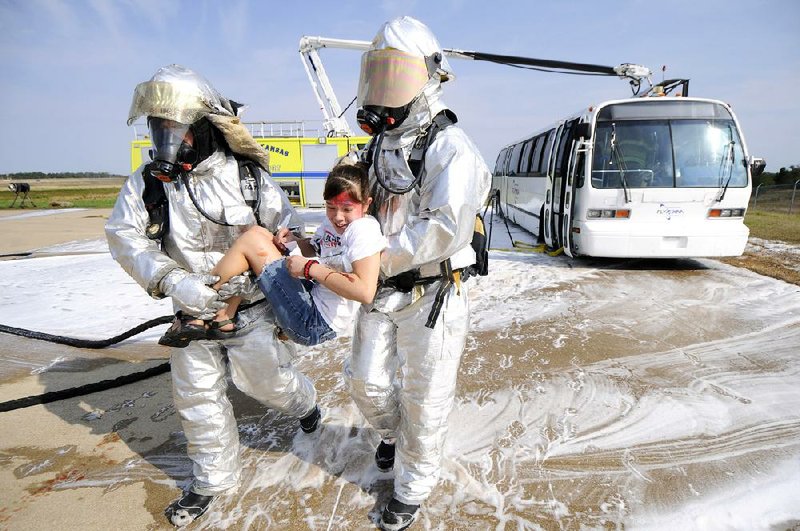HIGHFILL — About 9:30 a.m. Saturday at Northwest Arkansas Regional Airport, dozens of men, women and youths joined in a high-stakes game of pretend.
This was the scenario:
A McDonnell-Douglas MD-88 passenger jet with 150 people on board had limped toward the airport with flames and smoke pouring through the cabin and cockpit. The twin-engine jet managed a shaky landing, then rolled off the taxiway.
Now, wounded and dyingpassengers were trapped inside. Others crawled out to lie moaning or silent.
Firefighters converged to spray foam on the pavement, pierce the side of the aircraft and water down smoking wreckage. Rescue workers streamed in to treat victims, strap onto stretchers and load into ambulances.
It wasn’t a real crash. But Lowell Fire Chief Mike Morris was taking notes. Occasionally, he frowned. His job was to grade the responders’ work and devise ways to do the job better if, and when, a real tragedy occurs.
“I don’t like the way these apparatus (firetrucks) are lined up,” Morris said. “It causes the ambulances to be staged too far from the patients. It means you have to carry the stretchers much farther than you should.
“And I don’t like how they parked the tanker truck and then moved it to another spot,” he continued. “We lost a minute, or a minute and a half.”
Every three years, the Federal Aviation Administration requires airports such as Northwest Arkansas Regional to carry out a full-scale emergency exercise. Saturday’s was the first since October 2009.
Airport Public Safety Director Gilbert Neil began planning the simulation early this year. It attracted more than 60 firefighters, rescue workers and police from across Benton and Washington counties.
“It’s a great training tool,” Neil said. “People can read about what to do all day long. But once they get their hands on, that’s great training.”
Key players also included almost 50 teens and pre-teens from area 4-H and Civil Air Patrol groups. Painted with fake bruises and streaks of stage blood, they portrayed the plane passengers. Many of the young people clasped scripts detailing their pretend injuries. The notes also outlined how their characters should behave during the drill, and whether they ultimately lived or died.
McKinzie Hummel, 15, of Centerton had her face painted gray. Her role as Passenger 15 was to play a woman who was experiencing chest pains. Her line was, “I think I’m gonna die.” When about half the passengers were removed from the jet, her instructions were to keel over and play dead.
McKinzie’s Benton County 4-H group, named Teen Leaders, brought the young people to the event as a community service.
“I enjoy the fact they’re allowing the kids to do this,” said McKinzie’s mother, Christy Hummel, who watched part of the emergency drill. “It gives them a view into the heroes of our society - what our firefighters and EMTs are up against.”
At Saturday’s drill, an airport bus stood in for the crashed jet. But the firetrucks, ambulances and rescuers were all real. So were their uniforms, breathing tanks and first-aid equipment.
By 10 a.m., police radios spread the word: “All live victims are extricated.”
In the crash scenario, five passengers were considered deceased. Others supposedly sustained life-threatening injuries, including severed limbs. Firefighters and rescuers worked on for about another hour.
Morris said afterward that he thought the exercise went “very well.”
“We found a few opportunities for improvement,” he said. But planning the event and coordinating so many departments for a single emergency was important training, he said.
Northwest Arkansas Regional Airport, which opened in 1998, has not experienced a major crash or similar tragedy, Neil said. And Saturday’s exercise, for all its choreographed drama and bloody makeup, couldn’t supply the one factor that’s part of the real thing - human fear and panic in the face of lifethreatening emergency.
“There’s no way to create that real sense of emergency, that adrenaline factor,” Morris said. “That’s why we do this. You train. You get more competent in what you’re doing. Then you’re able to perform your best, to overcome the adrenaline when a real emergency comes.”
Northwest Arkansas, Pages 13 on 08/19/2012

